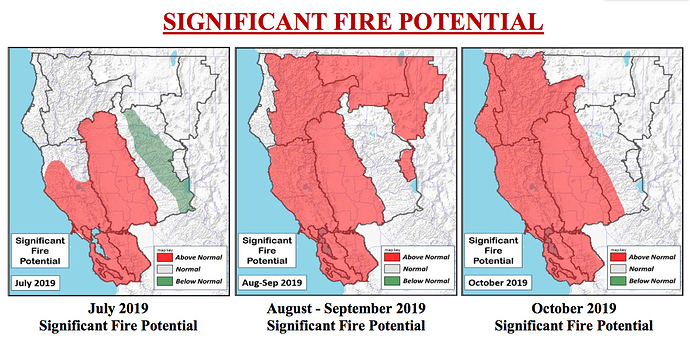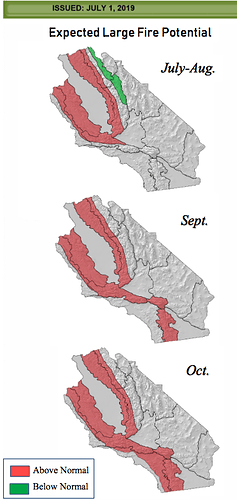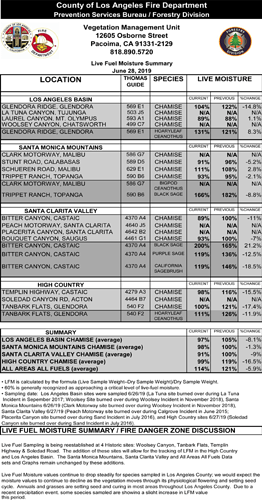It has been a while since Central and Northern Ca have had a wet warm spring. The most obvious result is that the annual grasses are much more abundant, however this winter spring pattern produces many other effects directly related to fire behavior and associated fire line safety as well as suppression tactics. I was in the Lake Almanor area last week and went up to a small lake at 5K elevation. The manzanita was in full bloom at the end of June! Some small snow patches were still present. In the North Bay where I live the creeks are still flowing when continuous flow usually stops in May. Yesterday I watched a grass fire in the east bay running a steep hill with wind and the smoke was mostly white and it struggled to jump single blade mid slope roads. The take away is that in drought years it has been game on by July . This year there is still lots of live fuel moisture significantly impacting fire behavior particularly in northerly, shaded and lower drainage areas. But this will change at some point this season starting in the foot hills and moving up in elevation. The concern is that folks on the line use current fire behavior as their base line for the season and there will be quite a surprise later in the season and surprises on the line are never good. It would be very helpful for SA and Safety if folks would post changes in fire behavior and fuel conditions they observe in their respective areas. LCES, 10’s and 18’s do no good if the information applied is inaccurate. Stay safe all.
The same could be said for fuels in Southern California. We’re just not there yet, but as always we will be soon enough. The high pressure that is forecasted to set up for next week should speed things up a bit. The desert interfaces have been ready to go though. And there has been activity in those areas to show that.
The other thing to consider is the weather has been cooler than normal. Coming up on mid July and there have been only a few 100 degree days scattered mostly in the north state. This reminds me of one of those years where everyone keeps looking for fire season ‘to get going’, but never quite does. The atmosphere just doesn’t seem right and I think Fall will be here sooner than later. Two years of wickedly out of control fire seasons gets replaced with a tranquil normal year.
Very true and that has been my experience as well. But occasionally a Severe FWX pattern come in and we have a dangerous fire or two. 1991 was a slow year, nothing seemed to get up and run for any period of time. then on October 19th a rekindle sparked the Oakland Hills Fire. 28 died and over 3,200 dwellings destroyed and many forget it rained the next day. So while we are due for a slow season don’t count on it until Christmas.
From South ops this morning
“IA may climb to moderate or approaching heavy levels from July 10th into the following
weekend.”
From Me:
“it’s not over till its over”
We’re going to have the fuel every year. Timing will change, but will boil down to how many stupid people do stupid things.
I was hoping this wold stay about fuel and weather condition changes in local areas so everyone can have an idea where different areas are regarding burning conditions. The FBANS on the old blog used to post very current information almost daily. Monthly outlooks, live fuel moisture readings and observations that experience tell you things are changing that is helpfull to SA.
Nothing matters without the start
LA County has had one of the best fuel monitoring programs for many years. This page shows the FM and trends but also the fuel type. Critical levels for Chamise is very different than say manzanita. Depending on the reference Chamise is between 58 and 68% or lower and Manzanita is 80 to 90%, I believe gamble oak is even higher. So be certain you are talking apples to apples when comparing FM and where critical levels are. The best definition of critical FM in live fuels is the point where the fire behavior characteristics are more like dead fuel than live. Also remember that in chaparral there is always a dead component to the fuel bed.
Burning conditions after many years of drought can be deceiving. It may take years for the vegetation to fully recover, so while fuel moistures might be up now, they may drop drastically once it dries out for the summer/fall and go back to critical levels relatively fast. Some areas may not even have live fuel moisture recovery much at all. So come fall we may just a have an inordinate amount of dry fuel.
While you are right on that there is more light fuel this year and it will dry out eventually, so if we have a sever FWX pattern it will be a huge issue, this light fuel bed can also continue over to next season and provide continuous ground fuel in the event of a drought this coming winter. None annual live fuels by definition have to have fuel moisture recovery and all the signs I see point to elevated live fuel moisture levels at this point in the summer. Areas with diseased or drought stressed will not recover as well as a healthy plant/tree but the trend is way up this year. The drought cycle has produced a large dead component in many live stands from chaparral to timber so even if the live fuels are moist, it is the dead fuel that drive the fire front until live fuels drop below critical when they begin to burn like dead fuels. The key is paying attention to all the fuel conditions so you can better predict fire behavior and match tactics and maintain safety.
The fish fire is a good example of what you are talking about with the high dead fuel component.
https://sierranewsonline.com/crews-gain-the-upper-hand-on-fish-fire-burning-on-sierra-nf/
hello guys,
It’s quite hot and dry there. The climate dries out lots of the underbrush, making it easy fuel.
Areas like that are also supposed to naturally burn. Forest fires are actually quite beneficial as they clear out the underbrush, fertilize the ground, and actually cause some species of trees to start growing (the fire is a vital step in their reproduction). However, many people stop fires from happening so the dry underbrush builds up for years. When it finally does catch there’s several years worth of material there and the fires get large and out of control.
thanks and regards
This is knowledge that every member on here has and it’s got nothing to do with said topic…
Your are correct in your description of the natural fire cycle. But that cycle began to end in 1910 with the total fire suppression policy followed by logging, exotic plant introduction and development into the forests. What is out there is totally different, most importantly the went winter and spring has provided for abundant vegetation growth. A bit late but it would seem that all has finally dried out and fires are up and running quickly and able to sustain significant fire behavior through the night in the absence of solar heating. This is the turning point in a fire-season where we get the multi day fires. These fires burn with very high intensity, significant runs causing near 100% mortality in shrubs and trees and even some areas of chaparral.
This season has a long ways to go and the possibility of severe FWX events before season ending precipitation is a near certainty. This means any fire still burning will get up and run and in CA that means threat to life and property with few exceptions. Like it or not, with only the very high remote areas exempt, all fires must be suppressed ASAP and put to bed so resources can be released and become available. Hopefully no one argues that forest management must be done better. But this idea of “let burn” or restrict use of suppression tools, say like dozers has no place in that discussion.
There are a lot of other factors involved here that add to the complexity of your post. One, and this is the biggest challenge we face, the protection of the civilian population who are pushing farther and farther into the wildland environment. When a fire occurs, public safety is our paramount objective and will overshadow any and all containment and control efforts. Fires such as the 2017 Tubbs Fire, the 2018 Carr Fire, the 2018 Camp Fire, and the 2018 Woolsey Fire are all examples of fires when suppressive efforts were seconded to public safety measures.
The second element that must be considered is people’s property and infrastructure damage. If we simply let fires burn whatever is in it’s path, the losses to property and infrastructure would be absolutely staggering.
Thirdly, while there are certainly some planet species, such as the Giant Sequoia and the Bristle Cone pine that require heat or fire to open the cone, those species in California are very much limited to isolated pockets within the State. Most of the indigenous plants in California do not require the presence of heat or flame to release the seeds. Additionally, the Fire necessary to facilitate those functions is low intensity heat, not the very high intensity heat that is generated by a very destructive wildland fire.
Fourth, the heat generated by a high intensity wildland fire is very often destructive to the soil chemistry, composition and moisture absorption characteristics. The 2017 Thomas Fire is a good example of the destructive aspects to the soil. The extreme heat seals the soil such that water/rain is not absorbed and simply runs off the surface, creating new issues with destructive mud and debris flows. Additionally, because the soil does not properly absorb rain fall, non indigenous plants such as star thistle take hold and prevent new annual grasses from germinating to begin to stabilize the soils.
Finally, there are very real health concerns from the toxins in the smoke, not only for us, but for the general public as well.
Are there times when fires are allowed to burn in California for fuel reduction purposes, absolutely. Do there need to be more and improved methods for forest management? Without question or hesitation.
Is the answer, simply to let each and every fire burn it’s natural path,? Absolutely not.
We absolutely recognize the points you made and they are all valid points but reality is not as simple as your post would suggest.



